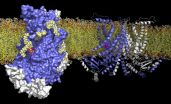Facial motion a clue to difficulties in social interaction among autistic adults
People with ASD struggle to recognise changing facial expressions
2014-11-13
(Press-News.org) People on the autistic spectrum may struggle to recognise social cues, unfamiliar people or even someone's gender because of an inability to interpret changing facial expressions, new research has found.
According to the study by academics at Brunel University London, adults with autism spectrum disorders (ASD), though able to recognise static faces, struggle with tasks that require them to discriminate between sequences of facial motion or to use facial motion as a cue to identity.
The research supports previous evidence to suggest that impairments in perceiving biological motion more generally may underlie difficulties in social interaction. This is in contrast to suggestions that poor attention skills are at the root of the problem.
Dr Justin O'Brien, from the Centre for Research in Infant Behaviour in the Department of Psychology at Brunel University London, and one of the authors of the study, said: "Existing studies have suggested that biological motion deficits are accountable for impairment in social cognition, but there has been little investigation of facial motion when discussing adults with ASD.
"Our data indicates that people with ASD are unable to pick up on changing visual information that informs their judgment of someone's identity or emotional state, and that this could contribute to difficulties in social interaction."
The study involved 14 participants, each high-functioning individuals with ASD, who were asked to watch motion captured from actors and applied to a three-dimensional face. The moving images were then used to investigate whether the participants could perceive and discriminate facial motion.
It is hoped the research will help build up a better idea of how and why adults with ASD have social and communication issues, paving the way for better understanding and treatment.
INFORMATION:
Notes to Editors:
'Impaired perception of facial motion in autism spectrum disorder' by Justin O'Brien, Janine Spencer, Christine Girges, Alan Johnston and Harold Hill is published by Plos One here.
Contact:
Keith Coles, External Communications Officer, Brunel University London, press-office@brunel.ac.uk, 01895 266599.
Dr Justin O'Brien, Lecturer in Psychology, Department of Life Sciences, Brunel University London, justin.obrien@brunel.ac.uk, 01895 265475.
[Attachments] See images for this press release:

ELSE PRESS RELEASES FROM THIS DATE:
2014-11-13
Membranes are thin walls that surround cells and protect their interior from the environment. These walls are composed of phospholipids, which, due to their amphiphilic nature, form bilayers with dis-tinct chemical properties: While the outward-facing headgroups are charged, the core of the bilayer is hydrophobic, which prevents charged molecules from passing through. The controlled flow of ions across the membrane, which is essential for the transmission of nerve impulses, is facilitated by ion channels, membrane proteins that provide gated pathways for ions. Analogous ...
2014-11-13
A cat always lands on its feet. At least, that's how the adage goes. Karen Liu hopes that in the future, this will be true of robots as well.
To understand the way feline or human behavior during falls might be applied to robot landings, Liu, an associate professor in the School of Interactive Computing (IC) at Georgia Tech, delved into the physics of everything from falling cats to the mid-air orientation of divers and astronauts.
In research presented at the 2014 IEE/RSJ International Conference on Intelligent Robots and Systems (IROS), Liu shared her studies of mid-air ...
2014-11-13
Weather, which changes day-to-day due to constant fluctuations in the atmosphere, and climate, which varies over decades, are familiar. More recently, a third regime, called "macroweather," has been used to describe the relatively stable regime between weather and climate.
A new study by researchers at McGill University and UCL finds that this same three-part pattern applies to atmospheric conditions on Mars. The results, published in Geophysical Research Letters, also show that the sun plays a major role in determining macroweather.
The research promises to advance ...
2014-11-13
Duchenne muscular dystrophy is the most common neuromuscular disease of children (affecting 1 boy in 3500-5000 births). It is caused by a genetic defect in the DMD gene residing on the X chromosome, which results in the absence of the dystrophin protein essential to the proper functioning of muscles.
The treatment being developed by researchers at Atlantic Gene Therapies, Généthon and the Institute of Myology, is based on the use of an AAV vector (Adeno Associated Virus) carrying a transgene for the skipping of a specific exon which allows functional dystrophin ...
2014-11-13
After graphene was first produced in the lab in 2004, thousands of laboratories began developing graphene products worldwide. Researchers were amazed by its lightweight and ultra-strong properties. Ten years later, scientists now search for other materials that have the same level of potential.
"We continue to work with graphene, and there are some applications where it works very well," said Mark Hersam, the Bette and Neison Harris Chair in Teaching Excellence at Northwestern University's McCormick School of Engineering and Applied Science, who is a graphene expert. ...
2014-11-13
High blood pressure - already a massive hidden killer in Nigeria - is set to sharply rise as the country adopts western lifestyles, a study suggests.
Researchers who conducted the first up-to-date nationwide estimate of the condition in Nigeria warn that this will strain the country's already-stretched health system.
Increased public awareness, lifestyle changes, screening and early detection are vital to tackle the increasing threat of the disease, they say.
High blood pressure - also known as hypertension - is twice as high in Nigeria compared with other East ...
2014-11-13
Researchers at The University of Texas have found that compared to Caucasian Americans, African Americans have impaired blood flow regulation in the brain that could contribute to a greater risk of cerebrovascular diseases such as stroke, transient ischaemic attack ("mini stroke"), subarachnoid haemorrhage or vascular dementia. These findings were published in Experimental Physiology, the journal of The Physiological Society.
Cerebrovascular diseases can result from reduced blood flow in affected areas of the brain. It is still unclear why African Americans are at higher ...
2014-11-13
Needles almost too small to be seen with the unaided eye could be the basis for new treatment options for two of the world's leading eye diseases: glaucoma and corneal neovascularization.
The microneedles, ranging in length from 400 to 700 microns, could provide a new way to deliver drugs to specific areas within the eye relevant to these diseases. By targeting the drugs only to specific parts of the eye instead of the entire eye, researchers hope to increase effectiveness, limit side effects, and reduce the amount of drug needed.
For glaucoma, which affects about 2.2 ...
2014-11-13
(PHILADELPHIA) - Glioblastoma is the most common aggressive primary brain tumor, and despite advances in standard treatment, the median survival is about 15 months (compared to 4 months without treatment). Researchers at Thomas Jefferson University have been working on a cancer vaccine that would extend that survival by activating the patient's immune system to fight the brain tumor. A study published online November 13th in the journal Cancer Immunology, Immunotherapy drilled down to the cellular and molecular mechanisms behind the vaccine, paving the way for further development ...
2014-11-13
Hospitalized premature infants are exposed to unsafe levels of a chemical found in numerous medical products used to treat them, raising questions about whether critically ill newborns may be adversely affected by equipment designed to help save their lives.
The chemical, di(2-ethylhexyl)phthalate (DEHP), is used to increase flexibility of many plastic devices. These products, made from polyvinyl chloride (PVC), include most intravenous tubing, catheters, endotracheal tubes, and fluid and blood product bags. DEHP doesn't bind chemically to PVC, and is able to leach into ...
LAST 30 PRESS RELEASES:
[Press-News.org] Facial motion a clue to difficulties in social interaction among autistic adults
People with ASD struggle to recognise changing facial expressions


